orthogonal frequency division multiplexing (OFDM) is the most popular modulation technique in modern wireless communication systems. Even though there are many advantages of OFDM, it has two main drawbacks: High peak-to-average power ratio (PAPR) and frequency offset. In this paper the issue of PAPR in OFDM is discussed. Due to the large number of subcarriers used, OFDM systems have a large dynamic signal range with a very high peak-to-average-power ratio (PAPR) which makes OFDM sensitive to nonlinear effects. This paper proposes a novel Haar-Wavelet based BPSK OFDM system. The Haar Wavelet transformation decomposes the data symbol sequence like half of the data symbols are zeros and the rest are √2 or -√2 and we can have the PAPR reduced by 3dB at most, compared with the conventional OFDM system. In this paper we propose a novel decoding algorithm for the proposed OFDM system, derive the bit error rate performance in theory. We compare cumulative distribution function for PAPR for the proposed OFDM v/s conventional OFDM and finally we compare the BER performance of our proposed OFDM system with the conventional one.
Keywords |
| Peak-to-average power ratio(PAPR); Bit error rate(BER); Haar Wavelet; Orthogonal frequency
division multiplexing(OFDM); |
INTRODUCTION |
| After more than thirty years of research and developments carried out in different places, orthogonal frequency
division multiplexing (OFDM) has been widely implemented in high speed digital communications. Due to the recent
advancements in digital signal processing (DSP) and very large scale integrated circuits (VLSI) technologies, the initial
obstacles of OFDM implementations do not exist anymore. Mean-while, the use of Fast Fourier transform (FFT)
algorithms has eliminated arrays of sinusoidal generators and coherent demodulation required in parallel data systems
and made the implementation of the technology cost effective. In recent years OFDM has gained a lot of interest in
diverse communication applications. This has been due to its favorable properties like high spectral efficiency and
robustness to channel fading. Recently OFDM has become the technique of choice for many broadband applications,
such as asymmetric digital subscriber line (ADSL) modems, digital audio broadcasting (DAB)[1], digital video
broadcasting(DVB)[2] and wireless local area networks (WLAN) systems (IEEE 802.11a [3], IEEE 802.11g[4]. In the
conventional serial data transmission system, the information symbols are transmitted sequentially where each symbol
occupies the entire available spectrum bandwidth. But in the OFDM system, the information is converted to N parallel
sub channels and sent at lower rates using frequency division multiplexing. The subcarrier frequency spacing is selected
carefully such that each subcarrier is located on the other sub-carrier zero crossing points. This implies that there is
overlapping among the subcarriers but will not interfere with each other, if they are sampled at the subcarrier
frequencies. This means that all subcarriers are orthogonal. |
| The frequency offset of the subcarriers and the high PAPR are the major drawbacks of OFDM [5]. However, due to
the large number of subcarriers used, OFDM system has a large dynamic signal range with a very high Peak-to-average
power ratio (PAPR). As a result OFDM signal will be clipped when passed through a nonlinear power amplifier at the
transmitter end. Clipping degrades the bit-error-rate (BER) performance and causes spectral spreading. One way to solve
this problem is to force the amplifier to work in its linear region [6]. In high speed digital wireless applications, the intersymbol
interference (ISI) channel may have spectral nulls, which may degrade the performance of the existing OFDM
system. Hence PAPR and spectral null channels need to be handled properly in implementation of OFDM systems |
| The Wavelet-OFDM system was widely studied in [7-9]. Wavelet-OFDM system just substitutes the DFT and IDFT
with DWT and IDWT, respectively. In this paper we propose a novel Haar wavelet based BPSK OFDM system. Since the data sequence produced by the BPSK modulator is either +1 or -1, the Haar wavelet transformation decomposes the
data symbol sequence like half of the data symbols are zeros and the rest are √2 or-√2. |
| Then the proposed BPSK OFDM system will have the PAPR reduced by 3dB at most, compared with the
conventional OFDM system. In this paper we also propose a novel decoding algorithm for the proposed OFDM system
to show robustness to spectral null channels. |
| The rest of the paper is organized as follows. The next section provides an introduction to Haar wavelet
transformation, followed by the principle of the proposed OFDM system, a novel decoding algorithm and the simulation
results. |
HAAR WAVELET TRANSFORMATION |
| Wavelets are a special kind of functions which exhibits oscillatory behavior for a short period of time and then die
out. The oldest and most basic wavelet system is named Haar wavelet that is a group of square waves with magnitude of
±1 in the interval [0, 1) [10, 11]. Haar wavelet has Haar two functions namely Haar scaling equation and wavelet
function, they are represented as, |
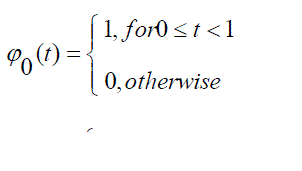 (1) (1) |
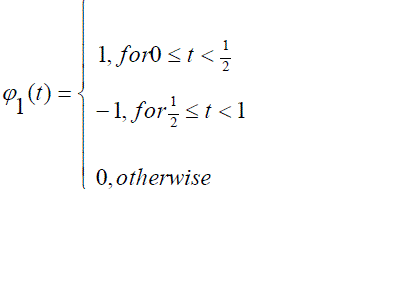 (2) (2) |
All the other subsequent functions are generated from  (3) (3) |
| Where |
| i = 2 + k, j≥ 0 j
And
j 0 ≤ k < 2j . All the Haar wavelets are orthogonal to each other. From the Haar functions,
the scale equation and wavelet equations are obtained as follows |
 (4) (4) |
 (5) (5) |
From the equations 4 and 5, we get low pass components as  and high pass components as and high pass components as  Using these filter components Haar wavelet decomposition over one-dimension digital signals
can be expressed as Using these filter components Haar wavelet decomposition over one-dimension digital signals
can be expressed as |
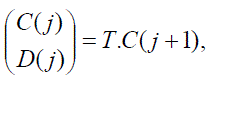 (6) And (6) And |
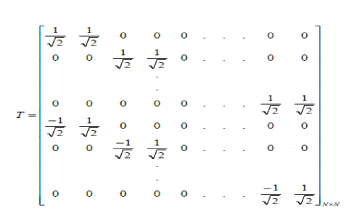 |
| From the equation (6), we can compute the approximation coefficients vector C(j) and detail coefficients vector D(j),
through operating Haar wavelet decomposition over the vector C(j+1). |
PROPOSED OFDM SYSTEM |
| The proposed Haar wavelet based BPSK OFDM system structure is shown in figure 1. From figure 1 we can observe
that the proposed OFDM system only increases Haar wavelet transformation at the transmitter compared with the
conventional OFDM system. |
| Some literatures use wavelet transformation to substitute the Fourier transform unit [7-9], which is different from our
paper. In this paper we use both wavelet transformation and Fourier transform unit. The proposed OFDM system has
many advantages over the conventional OFDM system. The advantages of our proposed OFDM system are obtained
from the Haar wavelet transformation. |
A. Principle of the proposed OFDM system. |
 |
| The detail process of Haar wavelet decomposition over input vector sequence x(n) is |
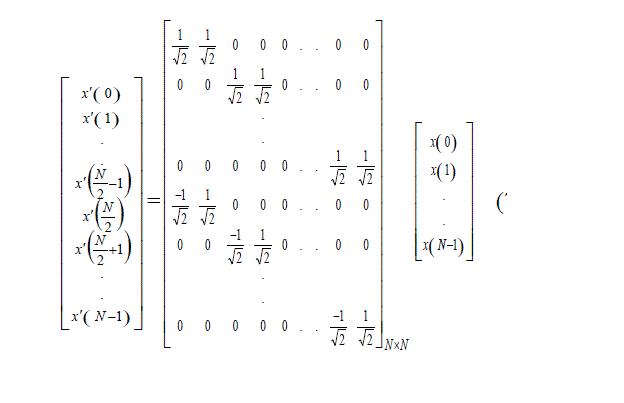 (7) (7) |
| From the equation (7), we can conclude that: |
 |
 (8) (8) |
| Similarly if x' (i)=0,i=0,1,........,N/2-1
then |
 (9) (9) |
 |
| Since Haar wavelet transform is added to the conventional OFDM system, the computational complexity may
increase. But the Haar wavelet transformation is simple to operate at the transmitter as follows |
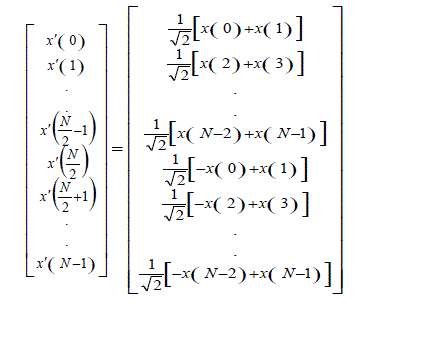 (10) (10) |
| From equation (10) we can say that the proposed OFDM system don’t increase too much computational complexity,
compared with the conventional OFDM system. |
PAPR PERFORMANCE |
| In this section, we study the PAPR benefits of the proposed OFDM system. In OFDM system, PAPR is the peak
power per OFDM symbol versus the average power in the same symbol [12, 13], i.e., mathematically |
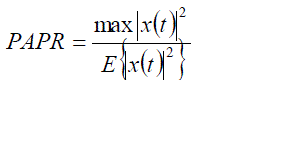 (11) (11) |
| Suppose that the average power of the conventional OFDM system is OFDM P with the signal peak value OFDM A and the
average power of the Haar wavelet-based BPSK OFDM system is DWT OFDM P / with the signal peak value DWT OFDM A / .
The average power of the conventional OFDM and the proposed OFDM system is equal for every frame, which can be
derived from Parseval theorem, which means |
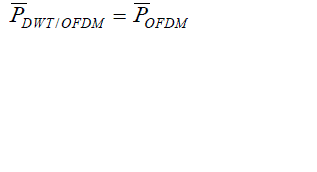 (12) (12) |
| Since the Haar wavelet transformation used in our proposed OFDM system, half of the information symbols are
zeros and the rest are either √2 or -√2 in each OFDM symbol. Hence non-zero symbols in Haar wavelet-based BPSK
OFDM system only occupies half of the subcarriers and the magnitude of each symbol is √2 times compared with
conventional OFDM system. Considering the worst situation (all subcarriers appear the maximal value at the same time),
we get |
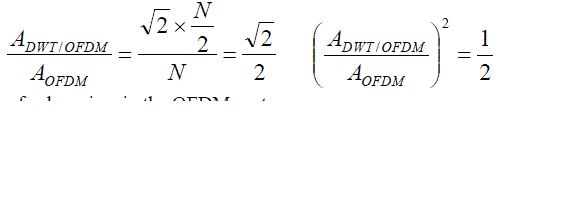 (13) (13) |
| N denotes number of subcarriers in the OFDM system. |
| Equation (13) says that peak power of the proposed OFDM system is reduced by half, compared with the
conventional OFDM system. So PAPR of the Haar wavelet based BPSK OFDM system is reduced by 3dB. Which
means proposed OFDM system is able to overcome the main drawback of conventional OFDM system. |
NOVEL DECODING ALGORITHM. |
| As we know, the output data sequence l y has the following relationship with the input data sequence x'l at the
th lth
subcarrier. |
 (14) (14) |
 |
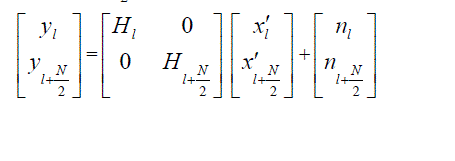 (15) (15) |
 |
| which is |
 |
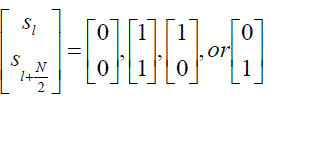 (16) (16) |
 |
 |
| The decoding algorithm consists of the correlation of the transmitted symbols sufficiently. |
SIMULATION RESULTS |
| In this section, we provide the simulation results of the cumulative distribution functions for PAPR for the proposed
OFDM versus conventional OFDM, simulation results of the BER versus SNR for conventional OFDM system versus
proposed OFDM system. |
| We assume 256 subcarriers, i.e., N=256, and assume BPSK modulation is used in conventional and proposed OFDM
systems. For simplicity, we assume that the maximum-likelihood (ML) estimation method is used at the receiver. one
can clearly see that the BER performance of proposed OFDM system is better than the conventional system. |
CONCLUSION |
| In this paper, we proposed a novel Haar wavelet-based BPSK OFDM system. The simulation results prove that the
proposed system has two advantages compared with conventional OFDM system: Reduces the PAPR by 3dB at most,
BER performance improves 3dB at most. Analysis also shows that proposed system does not increase too much
computational complexity at the transmitter. |
Figures at a glance |
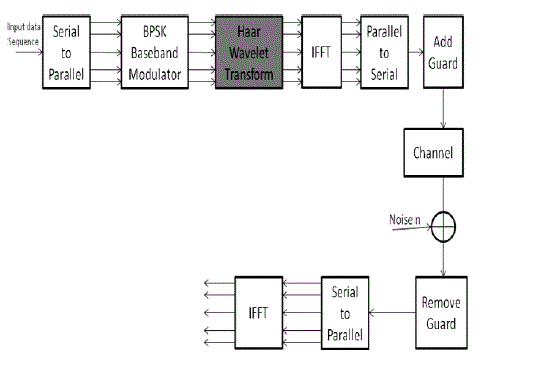 |
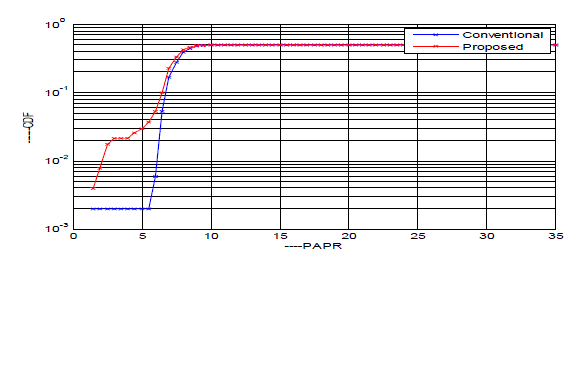 |
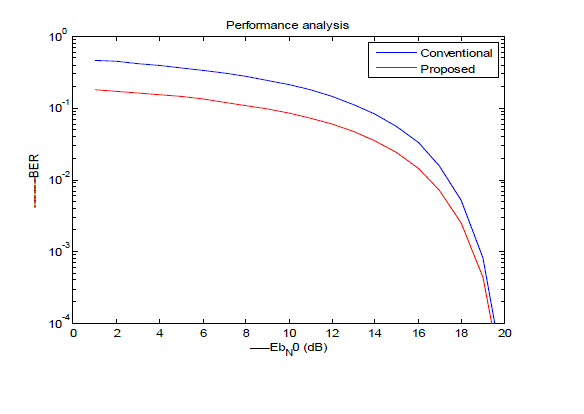 |
| Figure 1 |
Figure 2 |
Figure 3 |
|
| |
References |
- Shelswell, P., The COFDM Modulation system: The Heart of Digital Broadcasting, Electronic ans Communication Engineering journal, Vol 7, June, pp. 127-135, 1995.
- ISO/IES, Information Technology-generic Coding of moving pictures and Associated Audio Information: Part 2 video, Tech. Rep. 13818, ISO/IEC, 2000.
- Wu, H., Huang, X., &Xu, D. (2006). Novel semi-blind ICI equalization algorithm for wireless OFDM systems. IEEE Transctions on Broadcasting, 52(2), 211-218.
- Draft supplement to stndard for telecommunications and information exchange between systems-LAN/MSN specific requirements-part 11: Wireless MAC and PHY specifications: High speed physical layer in the 5 GHz band, IEEE 802.11, May1999.
- Wu, Y. and Zou, W. Y., Orthogonal frequency division Multiplexing: A multicarrier Modulation scheme, IEEE Transctions on consumer Electronics, Vol. 41, No. 3, August, pp 392-399, 1995.
- Slimane, S. B. (2007). Reducing the peak-to-average power ratio of OFDM signals through precoding. IEEE Transctions on Vehicular Technology. 56(2), 686-695.
- Oltean, M., &Nafornita, M. (2009). Error pre scale statistics for a wavelet OFDM transmission in flat fading channels. In Proceedings of IEEE WISP2009 (pp. 119-124).
- Lin. H., &Siohan, p. (2008). OFDM/OQAM with Hermitian symmetry: Design and performance for baseband communication. In Proceedings of IEEE ICC2008 (pp. 652-656).
- Mohsein, R., Sheikhi, A., &MasnadiShirazi, M. A. (2008). Wavelet packet based OFDM radar signals. In proceedings of IEEE ICUWB2008 (pp. 552-557).
- Davis, T.J. (1999). Fast decomposition of digital curves into polygons using the Haartransform. IEEE Transctions on Pattern analysis and Machine Intelligence, 21(8), 786-790.
- Hsiac, C., & Wang, W. (2000). State analysis and parameter estimation of bilinear systems via Haar wavelets. IEEE Transactions on circuits and systems 1: Fundamental theory and applications. 47(2), 246-250.
- Lin, Y. P., &Phoong, S. M. (2003). BER minimized OFDM systems with channel independent precoders. IEEE transactions on Signal processing, 51(9), 2369-2380.
- Yucek, T., &Arslan, H. (2007). MMSE noise plus interference power estimation in adaptive OFDM systems. IEEE Transactions on Vehicular Technology, 56(6), 3857-3863.
|